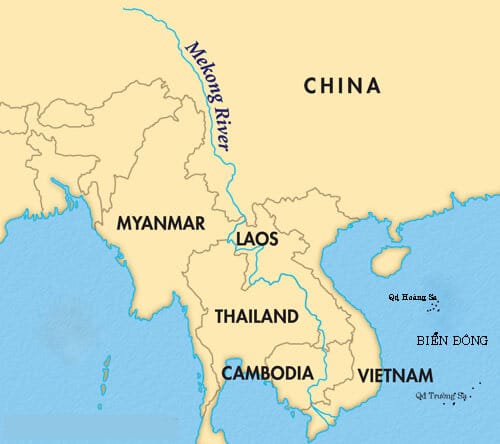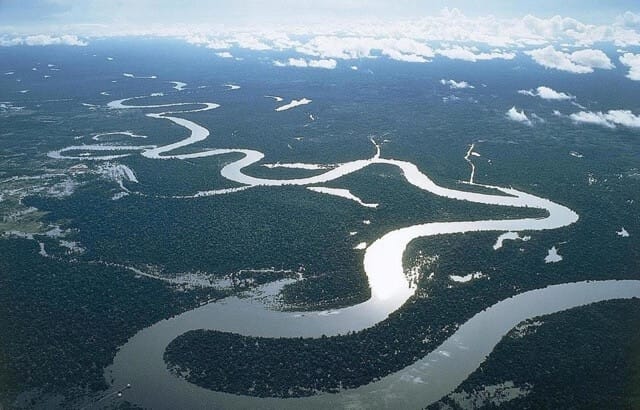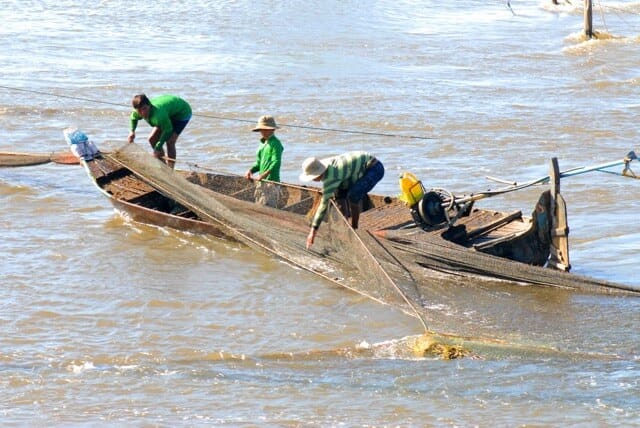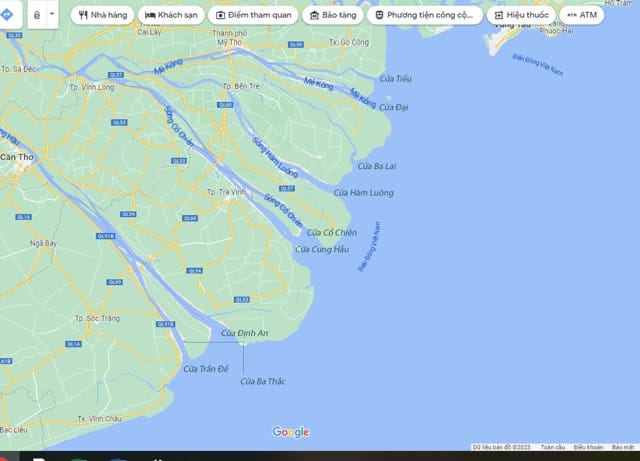The Mekong River is one of Southeast Asia’s most important waterways, stretching over 4,900 kilometers and passing through six different countries. Its rich cultural past, distinct ecosystems, and magnificent scenery make it a popular tourist destination for visitors worldwide.
In this post, we will look at the Cuu Long Delta region of Vietnam, which is famed for its colorful floating marketplaces, traditional villages, and breathtaking natural landscape. We will learn about the region’s history and culture, as well as the ecological beauties of the Mekong River and the daily lives of the locals.
See more: Exploring Rivers in Vietnam – Thrilling Adventures.
Contents
A Historical and Geographical Overview of the Mekong River
The Mekong River has a rich and fascinating history that has influenced Southeast Asia’s culture and way of life. The river has provided food, transportation, and water to the people who live along its banks for thousands of years. The Mekong River has also served as an important commerce route, allowing Southeast Asian countries to exchange commodities and ideas.
The Mekong River is the world’s 12th longest river, running 4,900 kilometers from its headwaters in the Tibetan Plateau to its delta in Vietnam. It runs across a total of six countries, including China, Myanmar, Laos, Thailand, Cambodia, and Vietnam, and has distinct names in each. The river supports a wide variety of ecosystems, including tropical forests, marshes, and mangroves, as well as a number of rare wildlife species, including the Irrawaddy dolphin and the gigantic freshwater stingray.

The topography of the Mekong River is defined by its extensive network of tributaries, which feed into the main river and form a complex web of canals necessary for transportation and agriculture.
The Cuu Long Delta in Vietnam is one of the country’s most productive and heavily populated regions, and it is home to a lively culture and way of life formed by the river’s history and topography.
Unveil the Beauty of Vietnam’s Perfume River on Your Adventure.
The Formation of the Mekong River Via Geological Perspective
The formation of the Mekong River can be traced back to a series of geological processes that occurred over millions of years. The river began to take shape during the late Cenozoic era, around 23 million years ago, when the Indian subcontinent collided with the Eurasian plate, creating the Himalayan mountain range. As the mountains rose, they made a high plateau in Tibet, which provided the initial source of the Mekong River.
Over time, the river’s path was shaped by various erosive processes, including glaciation, tectonic activity, and weathering. The river’s current course was established around 5 million years ago when the Southeast Asian landmass began to shift, causing the river to flow southward towards the sea.
Various physical features, including rapids and waterfalls, characterize the Mekong River. These features result from the river’s steep gradient, which drops from an elevation of over 5,000 meters in Tibet to sea level in Vietnam. The river’s rapids and waterfalls are particularly notable in the river’s upper reaches, where the terrain is rugged, and the water flows through narrow gorges and canyons.
Some of the most famous rapids and waterfalls on the Mekong River include the Khone Falls in Laos, which are the largest waterfalls by volume in Southeast Asia, and the Mekong Rapids in Cambodia, which are a popular destination for kayaking and rafting enthusiasts.

Exploring the Significance and Influence of the Mekong River
The Mekong River is critical to the lives of millions of people in Southeast Asia, providing food, water, and transportation. The river’s complex ecosystem supports a wide variety of fish species, which are a primary source of protein for many people who live along its banks.

Aside from fishing, the river benefits agriculture by allowing farmers to irrigate and fertilize their crops with river water.
The Mekong River also serves as a vital transit corridor, with boats and barges transporting products and people between villages and cities along its banks. The river is essential for isolated settlements that are not accessible by road since it serves as a lifeline for necessary supplies and services.
The Mekong River is also important to the region’s economy, with agriculture, fishing, and tourism being some of the key industries that rely on it. The rich delta of the Mekong River in Vietnam is one of the most prolific agricultural regions in the country, with farmers cultivating a variety of commodities such as rice, fruits, and vegetables.
Fishing is also an important sector, with the river supporting a healthy fishery that employs and provides income for many people.
Tourism is another industry that benefits from the Mekong River, with visitors coming to experience the river’s unique culture, history, and natural beauty.
The river’s delta in Vietnam, in particular, is a significant tourist destination, attracting travelers from all over the world with its colorful floating marketplaces, traditional communities, and breathtaking surroundings. The relevance of the Mekong River to the region’s economy and way of life emphasizes its value as a crucial resource for Southeast Asia.
Exploring the Historical Beauty of Vietnam’s Thu Bon River.
Tracing the Cultural and Historical Significance of the Mekong River in Vietnam
In Vietnam, the Mekong Delta is known as the Cuu Long River.
The river splits into two rivers, Tien Giang and Hau Giang, and runs into the sea through nine gates: Tieu, Dai, Ba Lai, Ham Luong, Co Chien, Cung Hau, Dinh An, Ba Thac (Bassac), and Tran De.

Because Me Kong’s nine rivers resemble nine flowing dragons, they are also known as the Cuu Long River, which can be literally translated as “the river of Nine Dragons.”
It is a vast territory located near the mouth of the Mekong River. It has a land area of about 40,000 square kilometers and a population of nearly 17 million people. The delta is an important location for Vietnam in terms of cultural significance and economic impact.
A network of rivers, canals, and islands characterizes the Mekong Delta’s landscape. The region is traversed by numerous waterways used for transportation, fishing, and agriculture.
There are also a number of islands in the delta, some of which are inhabited and others which are protected as nature reserves.
Agriculture is the principal industry in the Mekong Delta, which is critical to Vietnam’s economy. The delta is one of the most fruitful areas in the country, with farmers cultivating a wide range of crops such as rice, fruits, and vegetables.
Aquaculture is another critical business, as the delta’s rivers provide habitats for many diverse fish and shellfish species.
Tourism is also a growing industry in the Mekong Delta, with visitors coming to explore the region’s unique culture and natural beauty. The delta is known for its floating markets, where vendors sell various goods from their boats, as well as its traditional villages and stunning landscapes.
The delta also offers opportunities for eco-tourism, with visitors able to explore the region’s diverse ecosystems, including wetlands, mangroves, and forests.
The Mekong Delta is vital to Vietnam’s economy and cultural heritage. Its rich history, unique ecosystems, and vibrant way of life make it a fascinating destination for visitors worldwide.
Explore the natural beauty of Vietnam through the Dong Nai River.
Conclusion
The Mekong River is an important waterway in Southeast Asia, passing through six nations and supplying millions of people with food, water, and transportation. Vietnam’s Cuu Long Delta region is a popular tourist destination with its distinct culture, diversified ecological systems, and stunning landscapes.
Visitors can visit floating marketplaces and traditional villages and sample the region’s distinctive food and natural attractions. We invite readers to visit the Mekong Delta and explore its rich history, culture, and natural beauty.


Related Posts
Saigon’s “Flower Market Replica”: Where To Find Them
Ho Chi Minh City’s floral charm is not limited to its bustling wholesale markets. Imagine wandering through a place where vibrant petals, fragrant blooms, and the spirit of traditional Vietnamese markets come alive—without the overwhelming crowds. A flower market replica captures that magic, blending the beauty of fresh flowers with the charm of a curated, […]
Is it Safe to Travel to Vietnam Right Now? A Complete 2025 Guide
Vietnam has emerged as one of Southeast Asia’s most captivating destinations, drawing millions of visitors annually with its rich culture, stunning landscapes, and incredible cuisine. However, many travelers still ask: Is it safe to travel to Vietnam right now? This comprehensive guide provides you with everything you need to know about Vietnam travel safety in […]
Ho Chi Minh Cu Chi Tunnels Tour: The Ultimate Guide
The Cu Chi Tunnels stand as one of Vietnam’s most remarkable historical sites, offering visitors a profound glimpse into the ingenuity and resilience displayed during the Vietnam War. For travelers, a Ho Chi Minh Cu Chi tunnels tour represents an essential experience that combines education, adventure, and deep cultural understanding. This comprehensive guide will help […]